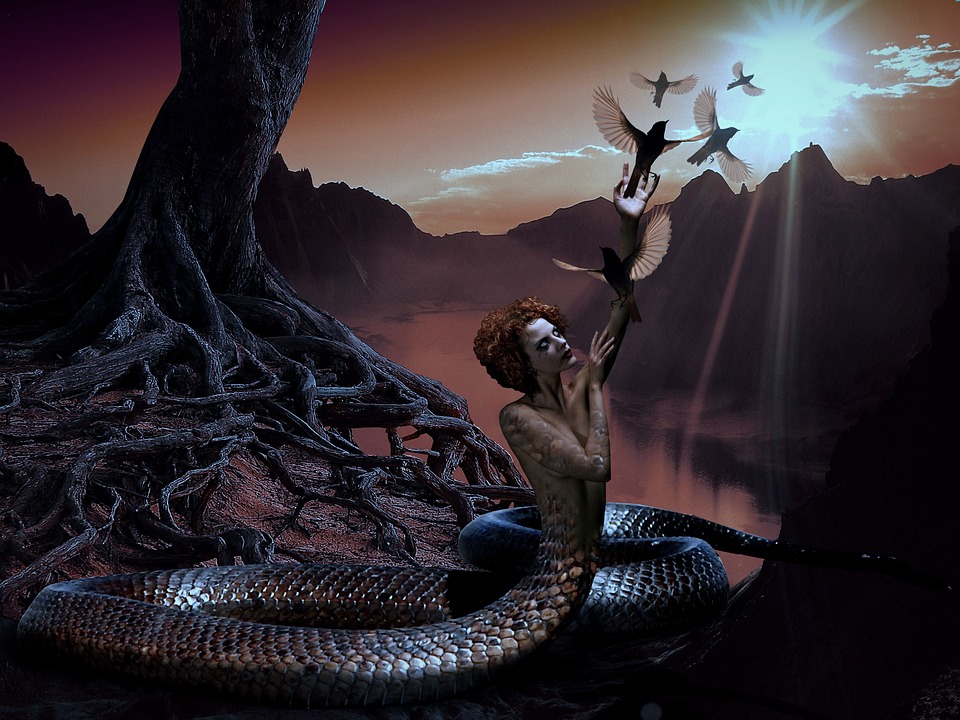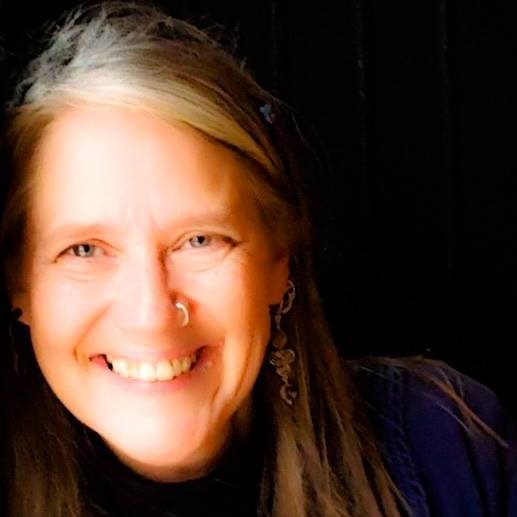by Patricia ‘Iolana, PhD
In an interview with Ross Downing, PhD candidate Áine Warren discusses her research into the ‘Dark Goddess’ at the University of Edinburgh. Drawn into this community of Dark Goddess adherents through her previous research into altars dedicated to the Celtic goddess The Morrigan, Warren examines similarities and differences among Dark Goddesses from various faith traditions including the Eastern Kali Ma, the Celtic Morrigan, and the Norse goddess Hel.
Focused on the female experience, discourse surrounding Dark Goddesses are as varied and complex as the myriad of goddesses that this sector of Goddess Spirituality entails. Warren accurately notes that, in this context, Dark, as a descriptor, refers to the nature of the goddess in question rather than a direct reference to skin colour. For example, the Black Madonna is often, and incorrectly, referred to as a Dark Goddess because of her dark skin, but that is not the nature in question here. In this context, Dark is indicative of what psychologist Carl Jung refers to as the ‘Shadow.’[i]
As Warren states, the Dark Goddess represents ‘part of nature relegated from society and religious practices.’ She is ‘not to be approached; not to be encouraged, and not to be approached within the self’, yet, for an adherent, working with the Dark Goddess is a vital part of any wholistic understanding of self and nature. Mirroring my own ethnographic research within the Western Goddess Movement, Warren found that the Dark Goddess worshiped in the West bears striking similarities to Eastern Dark Goddesses despite historical and cultural differences.
However, while Warren has found a consensus on the nature of the Dark Goddess amongst the texts and YouTube communities that she is examining, not all adherents within contemporary Goddess Spirituality view the Dark Goddess in the same way. In fact, the Dark, or Shadow aspect of Goddess, is a point of heated debate within the Goddess community amongst adherents, feminist theologians, and thealogians. Some Goddess Feminists, such as Carol P. Christ, refute the Dark Goddess as a projection of patriarchy.[ii] Christ favours the opinion that these ‘dark’ and often hostile characteristics applied to Dark Goddesses are a product of the patriarchal lens, which transmutes the goddess into a female hammer for male dominance. This is especially true with goddesses, such as Kali Ma and The Morrigan, who are intricately connected to the art of battle and warfare. Christ, understanding warfare as a patriarchal construct posits that this is an unnatural drive for feminine deities while others embrace the Dark Goddess as part of a greater whole Divine Being.[iii]
It is somewhat problematic to have a dialogue about the Dark Goddess without acknowledging the significant influence of the psychodynamics of Carl Gustav Jung. When asked about the connection between the Dark Goddess and Jung, Warren states that no one has ‘drawn that line’ between Jung and these practices. This is where one must wonder if it was a moment of Jungian synchronicity that Warren’s podcast made its way into my email inbox because my doctoral research directly connects Jung to the birth of the contemporary Western Goddess Movement. (For my conversation with Karen Tate on the topic, click here.) In fact, this isn’t just a ‘therapeutic’ element in Goddess Spirituality as Warren claims; Jung and his student M. Esther Harding who originally brought these ideas to American in the early 1900s have given birth to a psychodynamic Goddess-centred faith tradition. Over the years, Jung’s original ideas about Goddess, whom he often refers to as the Anima or the Anima Mundi (the World Soul), have been transformed by feminist theories beginning with Harding in 1935[iv] and further revised by Naomi Goldenberg in 1976[v] through to Susan Rowland’s in-depth 2002 study Jung: A Feminist Revision and beyond into contemporary academic research such as my 2016 doctoral study[vi] of Jung’s influence on the Western Goddess Movement, which traces the roots of a Western post-Jungian Goddess religion back to Jung and Harding through the analysis of an emerging thealogy (goddess-centred) found in contemporary women’s spiritual memoirs. The goddess who was once merely an archetypal theory for Jung (divine immanence in theological terms) has crossed the bridge from the psyche into the real world as various forms of the Goddess are understood as existing beyond the psyche in the natural world (transcendent in theological terms) and are actively worshiped as transcendent beings of divinity.
For Jung, the Dark Goddess is the epitome of one’s ‘Shadow’, and Jung’s concept of the ‘Shadow’ has theological implications. In Aion, Jung writes:
The shadow is a moral problem that challenges the whole ego-personality, for no one can become conscious of the shadow without considerable moral effort. To become conscious of it involves recognising the dark aspects of the personality as present and real. This act is the essential condition for any kind of self-knowledge, and it therefore, as a rule, meets with considerable resistance.[vii]
Jung’s model of psychological holism which he deems a path of Individuation[viii] begins with the crucial step of confronting one’s shadow and offers a distinctly feminine alternative to the patriarchal theological construct of sin and evil as disparate parts of ourselves that must be repressed and ignored; instead, Jung offers a system whereby one must integrate one’s shadow. Not only does Jung ask individuals to stare into the face of their own evil, he asks individuals to embrace this part of themselves as a natural element, which is in direct opposition to the Christian doctrine of evil as the construct of Satan which must, at all costs to the ‘salvation’ of the individual, be avoided.
What post-Jungian Goddess Spirituality offers adherents, and especially women, is an alternate way to both describe and experience the ineffable. More importantly, Jung’s path to Goddess offers adherents a space where their own personal experiences are accepted without question or doubt. Validity is removed as an obstacle to belief. Jung writes:
…there is no question of belief, but of experience. Religious experience is absolute. It is indisputable. You can only say that you have never had such an experience, and your opponent will say: “Sorry, I have.” And there your discussion will come to an end.[ix] (emphasis added)
Jung’s theories and models offer an empowering and authentic internal source of power in Goddess. The Dark Goddess is either understood as one side of a multi-faceted Great Goddess (Magna Mater) or as individual goddesses in a pantheon of hundreds.[x] She is a force of death and destruction, and truly encountering a Dark Goddess comes with a steep price. Working with the Dark Goddess often brings the individual to a point of psychological deconstruction. Christine Downing eloquently speaks of her own interaction with the Dark Goddess Persephone in her 1981 memoir The Goddess: Mythological Images of the Feminine. Downing relates how facing fear, weakness, and helplessness brought a significant shift in her psyche. Persephone’s lesson (and the lesson of all Dark Goddesses) was that without weakness and fear one cannot truly know strength and courage. She teaches us that we are capable of both great love and compassion as well as great evil and terrible power. The Dark Goddess shows us our frailties, our weaknesses, and our strengths. She will destroy existing paradigms and provide the path to rebuilding one’s self anew – whole and complete as individuals – empowered. This is the true influence of the Dark Goddess.
- [i] See Jung, Carl G. (1976) The Portable Jung. Hull RFC (Trans), Campbell J (ed). New York: Penguin Books, The Viking Portable Library, p145-147.
- [ii] See Christ, Carol P. (1997) Rebirth of the Goddess: Finding Meaning in Feminist Spirituality. New York: Routledge; and (2003) She Who Changes: Re-Imagining the Divine in the World. New York: Palgrave Macmillan.
- [iii] See Woodman, Marion and Dickson, Elinor. (1996) Dancing in the Flames: The Dark Goddess in the Transformation of Consciousness. Boston: Shambhala Publications. Downing, Christine. (2007 [1981]) The Goddess: Mythological Images of the Feminine. Lincoln, NE: Authors Choice Press. Wehr, Demaris S. (1987) Jung & Feminism. Boston: Beacon Press. Bolen, Jean Shinoda. (1984) Goddesses in Everywoman: Powerful Archetypes in Women’s Lives. New York: One Spirit.
- [iv] See Harding, M. Esther. (1971) Woman’s Mysteries: Ancient and Modern. Introduction by CG Jung. Boston: Shambhala Publications.
- [v] Goldenberg, Naomi R. (1976) A Feminist Critique of Jung. In: Signs 2.2, Chicago: University of Chicago Press, 443–449.
- [vi] ‘Iolana, Patricia. (2016) Jung and Goddess: The Significance of Jungian and post-Jungian Theory to the Development of the Western Goddess Movement. Doctoral thesis, University of Glasgow. Publication forthcoming. See Also: (2018) ‘Jung’s Legacy: The Western Goddess Movement’. In: MacKian, S., Pile, S., and Bartonlini, N. (eds). (2018) Spaces of Spirituality. London: Routledge, 245-259.
- [vii] Jung, Carl G. (1976) The Portable Jung. Hull RFC (Trans), Campbell J (ed). New York: Penguin Books, The Viking Portable Library, p144.
- [viii] Jung, Carl G. (1968) The Archetypes and the Collective Unconscious, Second Edition. Hull RFC (Trans) Read Sir H, Fordham M, Adler G and McGuire W (eds) Princeton, NJ: Princeton University Press, Bollingen Series XX, p275.
- [ix] Jung Carl G. (1938) Psychology and Religion. New Haven, CT: Yale University Press, p113.
- [x] See Perera, Sylvia Brinton. (1981) Descent to the Goddess: A Way of Initiation for Women. Toronto: Inner City Books and Farrar, Janet and Farrar, Stewart. (1987) The Witches’ Goddess: The Feminine Principle of Divinity. Custer, WA: Phoenix Publishing.



